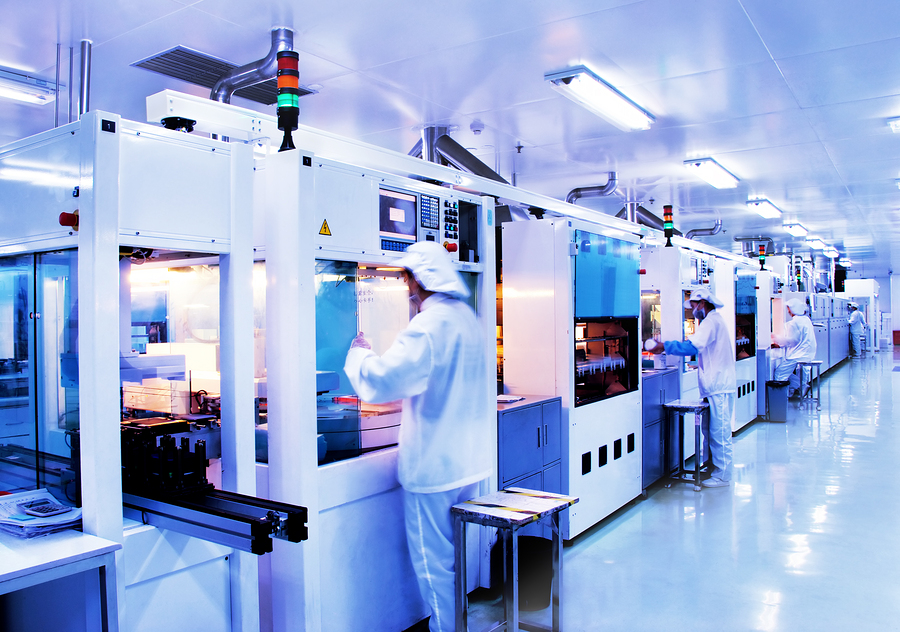
Robohub.org
Robohub roundtable: Job loss through automation, Foxconn controversy

Automated production line in modern factory.
Every few weeks, Robohub will post a roundtable chat and discuss an engaging topic relating to robotics. In this edition, we looked at the controversial job loss of 60K jobs by Foxconn. Is this substantial job loss a preview to come with automation, or largely overblown hype? We strongly encourage our Robohub readers to chime in and be part of the conversation!
This chat features Sabine Hauert, Andra Keay, Kassie Perlongo, Yannis Erripis, John Payne, providing a range of perspectives from research, business, and the general public.
Automation cutting jobs. Robots stealing jobs. The loss of human workers. How many times have different iterations appeared in the media with these all too similar headlines? When news broke about Foxconn cutting 60,000 jobs from their factory, mass speculation spread like wildfire. Chinese companies say they are looking to combine people with robotics, and that it will improve product quality whilst also ensure labour supply is not a factor to production. So, is China looking at a long-term gain, with a short-term loss, so they can continue to make their own products on their mainland?
Once the offshore labour capital of the world, China has rising costs and a higher standard of living, making it difficult to find workers. President Xi Jinping called for an “industrial robot revolution” in 2014, looking to place automation’s role in raising productivity. Due to this, Chinese companies are turning to robots, announcing measures — such as subsidies and tax incentives — to encourage ‘more industrial automation and development of home-grown robotics.’ By the end of this year, China will overtake Japan to be the world’s biggest operator of industrial robots, according to the International Federation of Robotics (IFR), an industry lobby group.
But back to Foxconn. After the news broke, they released a statement: “We are applying robotics engineering and other innovative manufacturing technologies to replace repetitive tasks previously done by employees, and through training, also enabling our employees to focus on higher value-added elements in the manufacturing process, such as research and development, process control and quality control. We will continue to harness automation and manpower in our manufacturing operations, and we expect to maintain our significant workforce in China.”
The company still employs more than 1.2 million people. If businesses grow more efficient and competitive due to robotics, are robots in some ways helping to prevent businesses from shutting down, with potentially more people losing jobs? Some tasks currently done by humans can be automated at low-cost while others, such as fine manipulation or visual inspection, will require sophisticated hardware and software to mechanise.
The roundtable began by discussing how robotics alleviates risk with people working in dirty, dangerous conditions. And also how this plays into the government’s plan to infuse capital into the mainland robotics industry over the next few years.
“The increase in automation is partly due to the increase in labour costs, but it is also in response to things that happened, like the factory explosion due to unsafe working conditions, killing people. The government pledged 2 billion yuan in subsidies for companies to install industrial robotics and production lines,” said Andra.
“I remember reading exposés about terrible working conditions. It’s not necessarily a bad thing to be introducing robots,” said Andra. “It may be ‘viewed’ as threatening, but it can be beneficial. So instead of people being pushed into horrible working conditions, robots will take care of it,” said Andra.
((As an aside, Foxconn echoes similar concerns, with Day Chia-Peng, general manager of Foxconn’s automation technology development committee, saying that the company was motivated to focus on this area due to safety concerns and manpower shortages in recent years.))
“There are always going to be people working in some of the most dangerous jobs in society, so there’s a question of whether robotics can improve the quality of some of the worst jobs for these people,” Andra continued.
“People often forget how difficult it is to make a robot. The goal is not to make robots that replace humans, but robots that work alongside humans, performing specific tasks. There is a large push to develop collaborative robots (cobots) that are easy to program and deploy by workers. This will allow the workers to focus on more fulfilling high-level tasks that require human-level cognition, and the robots, to focus on specific repetitive tasks,” said Sabine.
The roundtable also discussed China’s strategy for investing and utilising industrial robotics. As noted by the Financial Times, their working age population is expected to fall from one billion people last year to 960 million in 2030, and 800 million by 2050. Automation can be a way to fill the labour gap.
“China has increased their robotics to 1 million robots in 2 years,” said Andra. “The number of robots of China is increasing. They have a middle class that is ageing, and they are expecting a higher standard of living and a higher quality of job. The cost of labour in China has increased, and manufacturing has shifted to other parts of the world.”
“What we’re seeing today, is that robots introduced in factories have contributed overall to an increase in productivity. Higher production leads to more jobs down the road in other sectors such as sales, customer support, and for the overall deployment, installation, maintenance, and management of high-tech factories. While it’s true that the nature of work might change, the net number of jobs may not necessary decrease. The question is how to retrain workers,” said Sabine.
The roundtable mentions that China has relied on a seemingly endless supply of cheap labour for decades to power its economic expansion. “Fast forward to today and the production of robots and China is now the largest consumer of industrial robots and is approaching becoming one of the largest producers,” said Andra.
“Is there also a problem that it’s all happening too quickly and not a gradual pace for people to find new jobs?” asked Kassie.
“I think the pace the automation is increasing, but we’re still talking about a fairly small density,” said Andra.
“One hope is that the jobs of tomorrow are more fulfilling. The nature of work has always evolved, driven in part by the introduction of technology. We don’t manually wash our clothes anymore, and I don’t see why we should be performing the same repetitive task on an assembly line either,” said Sabine.
“Job displacement doesn’t mean everyone needs to become an engineer, although we are very much in need for more people, especially women, in the STEM fields. There is also room for jobs that profoundly build on human interactions and creativity. In fact, I hope all professions will become more human,” said Sabine.
“Augmented reality will make training easier and human workers more effective,” said John. “By replacing shortages of health care professionals (not doctors) robots can help here — replacing tasks, not replacing jobs. I don’t think we have to leave people out of the meaningful economy. Eyes, brains, and hands are wonderful things. Add augmented reality and you have a powerful combination.”
Final thoughts…
In 2013, the most widely noted report on the subject came from Oxford University’s Carl Benedikt Frey and Michael Osborne, “The Future of Employment: How Susceptible Are Jobs to Computerisation?” However, a new report has also been making waves. The report from Organisation for Economic Co-operation and Development (OECD), “The Risk of Automation for Jobs in OECD Countries: A Comparative Analysis,” by Melanie Arntz, Terry Gregory, and Ulrich Zierahn, finds that there actually will be jobs for people, but still foresees difficulties, particularly for low-skilled workers. It’s also important to note that these reports do not specifically discuss robotics, but also software automation.
Also, just because something can be automated doesn’t mean it necessarily will be. Although we have current technology to purchase coffee by machine, there are still people lining up at coffee houses, like Starbucks, to order their favourite brew. The human aspect is more important.
Finally, the robotic component of this overhaul in China will be about more than just installing more robots in manufacturing plants; and perhaps, robots shouldn’t be seen as a cure-all solution for the nation’s labour shortages and economic slowdown.
Read some of our previous Robohub roundtables below:
- Robohub roundtable: Why is it so difficult to define ‘robot’?
- Robohub roundtable: Robotics and space exploration
See all the latest robotics news on Robohub, or sign up for our weekly newsletter.
tags: c-Industrial-Automation, FOXCONN, robohub focus on standardization, Robohub roundtable, robotics



